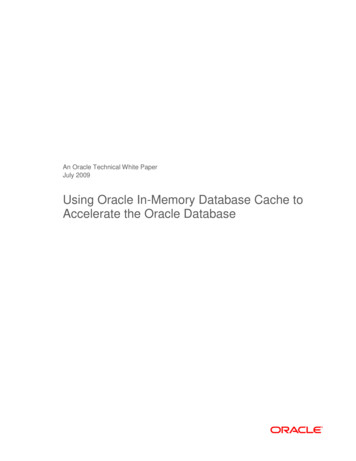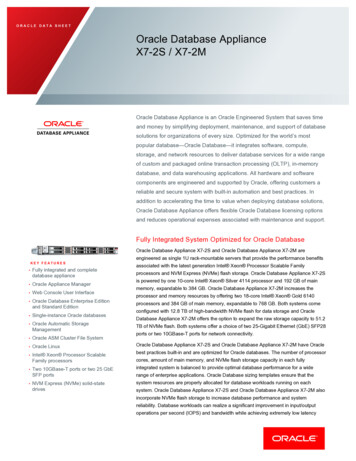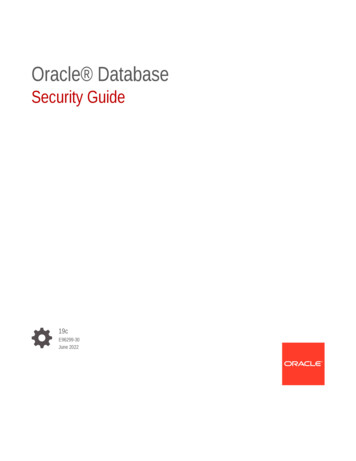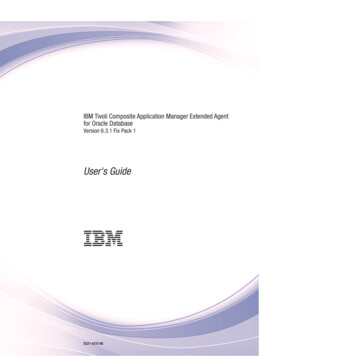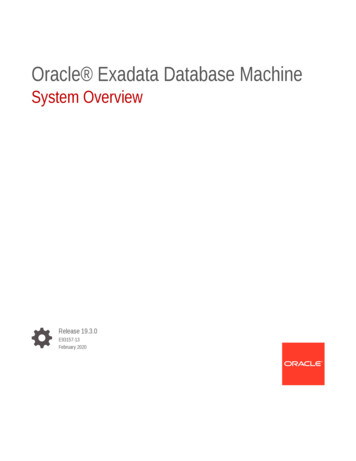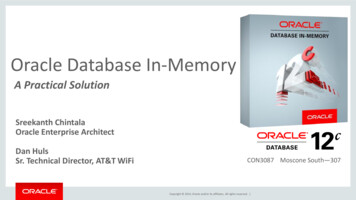
Transcription
Oracle Database In-MemoryA Practical SolutionSreekanth ChintalaOracle Enterprise ArchitectDan HulsSr. Technical Director, AT&T WiFiCON3087 Moscone South—307Copyright 2014, Oracle and/or its affiliates. All rights reserved.
Safe Harbor StatementThe following is intended to outline our general product direction. It is intended forinformation purposes only, and may not be incorporated into any contract. It is not acommitment to deliver any material, code, or functionality, and should not be relied uponin making purchasing decisions. The development, release, and timing of any features orfunctionality described for Oracle’s products remains at the sole discretion of Oracle.Copyright 2014, Oracle and/or its affiliates. All rights reserved. Oracle Confidential – Internal
Agenda1In Memory Overview25 Reasons To Consider In Memory3Data Warehouse Use Case4Lessons Learned5Testing MethodologyCopyright 2014, Oracle and/or its affiliates. All rights reserved. Oracle Confidential – Internal
Oracle Database In-Memory GoalsReal TimeAnalyticsAccelerate MixedWorkload OLTPAccelerate Mixed Workload OLTPNo Changes toApplications100xCopyright 2014, Oracle and/or its affiliates. All rights reserved. Trivial toImplement
Breakthrough: Dual Format DatabaseNormalBuffer CacheNew In-MemoryFormatSALESSALESRowFormatColumnFormat BOTH row and columnformats for same table Simultaneously active andtransactionally consistent Analytics & reporting use newin-memory Column format OLTP uses proven row formatSALESCopyright 2014, Oracle and/or its affiliates. All rights reserved. 5
Oracle In-Memory Columnar TechnologyPure In-Memory Columnar Pure in-memory column format Not persistent, and no logging Quick to change data: fast OLTP Enabled at table or partition Only active data in-memorySALES 2x to 20x compression typical Available on all hardwareplatformsCopyright 2014, Oracle and/or its affiliates. All rights reserved. 6
Agenda1In Memory Overview25 Reasons To Consider In Memory3Data Warehouse Use Case4Lessons Learned5Testing MethodologyCopyright 2014, Oracle and/or its affiliates. All rights reserved. Oracle Confidential – Internal
Top 5 Reasons to Consider In Memory#1#2#3#4#5Supports both OLTP and Data WarehouseMaximum Availability is Built InDatabase Size Isn’t Limited by MemoryAll Applications are Transparently CompatibleNo Additional Personnel/Training NeededCopyright 2014, Oracle and/or its affiliates. All rights reserved.
#1 Supports both OLTP and Data WarehouseUntil Now Must Choose One Format and Suffer TradeoffsMemoryOLTP uses row formatOLTP Transactions run faster on row format– Insert or query a sales order– Fast processing few rows, manycolumnsRowFormatORDERColumnFormatAnalytics & reporting useNew Column formatREGIONAnalytics Analytics run faster on column format– Report on sales totals by region– Fast accessing few columns, manyrowsCopyright 2014, Oracle and/or its affiliates. All rights reserved.
#2 Maximum Availability is Built InData Guard / GoldenGate Pure In-Memory format does not changeOracle’s storage format, logging, backup,recovery, etc.Real ApplicationClusters (RAC) All Oracle’s mature availabilitytechnologies work transparentlyAutomatic StorageManagement (ASM) Protection from all failures– Node, site, corruption, error, etc.Recovery Manager(RMAN)Copyright 2014, Oracle and/or its affiliates. All rights reserved.
#3 Database Size Isn’t Limited by Memory Specify tables, partitions or columns in-memory, not whole databasesDRAMHottest Data Data is transparently accessed acrossstorage tiers Engineered Systems automatic tieredstoragePCI FLASHActive DataCapacity of DiskIOsof FlashSpeed of DRAMDISKCopyright 2014, Oracle and/or its affiliates. All rights reserved. Cold Data
#5 No New Personnel Needed Use your existing Oracleteams – applicationdevelopers and DBAs HANA requires special3 Easy Steps to Oracle In-Memory Specify memory capacity inmemory size XXXX GB Configure tables or partitions to be in memory alter table partition inmemory; Later drop analytic indexes to speed up OLTPtraining and skillsAvailable wherever Oracle Database 12c runsCopyright 2014, Oracle and/or its affiliates. All rights reserved.
Agenda1In Memory Overview25 Reasons To Consider In Memory3Data Warehouse Use Case4Lessons Learned5Testing MethodologyCopyright 2014, Oracle and/or its affiliates. All rights reserved. Oracle Confidential – Internal
Early Adopters – DW Use Case Provides Wi-Fi hotspots in over45,000 locations across theUnited States Venues include hotels, airports,sports arenas, retail stores, fastfood chains, etc.Copyright 2014, Oracle and/or its affiliates. All rights reserved. Oracle Confidential – Highly Restricted14
Original ConfigurationEnterprise Customer Reports27 million Wi-Fi CustomersConnect to Hotspots via mobile devicesInternal CustomerReportsCopy DataHourlyDW20 TBOracle 11gR2 2-node RAC8 CPUs / nodeOLTP6TB Oracle 11gR2 4-node RAC32 CPUs / nodeCopyright 2014, Oracle and/or its affiliates. All rights reserved.
Business Concerns Enterprise customers access Wi-Fi reports daily through Business Objects Unable to meet enterprise customers’ expectations– Missed performance SLAs of critical reports– 15 minute timeout resulted in customers not being able to access some reports– Hourly data load job impacted by increased number of indexes– Need faster system to handle new business reporting requirements Poor performance resulted in:– Delayed rollout of new reports and near real time reports– Impact on customer satisfaction, with possible impact to revenue generationcapabilitiesCopyright 2014, Oracle and/or its affiliates. All rights reserved. Oracle Confidential – Highly Restricted16
Proposed Solution 1Enterprise Customer Reports27 million AT&T Wi-Fi CustomersConnect to Hotspots via mobile devicesInternal CustomerReportsCopy DataHourlyDW20 TBCopy DataOLTP6TB Oracle 11gR2 4-node RACCopyright 2014, Oracle and/or its affiliates. All rights reserved.
Proposed Solution 2Enterprise Customer Reports27 million AT&T Wi-Fi CustomersConnect to Hotspots via mobile devicesInternal CustomerReportsCopy DataHourlyDW20 TBOracle Database 12cWith In-Memory optionOLTP6TB Oracle 11gR2 4-node RACCopyright 2014, Oracle and/or its affiliates. All rights reserved.
Challenges with Proposed Solution 1 Requires new HW Relatively expensive S/W licenses Makes it very expensive to scale, limiting the number of reports they can offer There is very limited High Availability and no transparent failover options Need to hire highly specialized staff Another copy of data Extra level of effort in order to develop and manage these new processes.CostTime to marketResource RequirementsCopyright 2014, Oracle and/or its affiliates. All rights reserved.
Cost of AcquisitionStep 1: Purchase HANA Licenses and HANA Appliances– License cost depends on customer’s ULA, but can exceed 1,000,000– All data must be in memory – HANA cannot tier less active data to flash or diskStep 2: Hire/Train a New Team of DBAs and Developers– HANA consultants @ 150,000 per year, if availableStep 3: Migrate and Transform Databases into HANA FormatStep 4: Rewrite Custom AppsStep 5: Introduce a New Operational RegimenThis is in Addition to Your Current RDBMS OrganizationHANA S/W & H/W Re-coding Data Migration New Team Copyright 2014, Oracle and/or its affiliates. All rights reserved.
Comparison with HANA– High cost of acquisition New hardware & software costs– Application redesign– Redesign of aggregations– Training: Application & DBA Teams– Time to Market: 6 months – 1 year– Dedicated resources to maintain &manage: Min 6– One more copy of data– Incremental license cost & memoryupgrade (fraction of money)– No application changes– No changes to aggregations– Minimal training to DBAs– 2 months to production deployment– No additional head countBusiness ValueLicensing of SAP HANA alone was costprohibitive compared to Oracle In-MemoryCopyright 2014, Oracle and/or its affiliates. All rights reserved.
Final ConfigurationEnterprise Customer Reports27 million AT&T Wi-Fi CustomersConnect to Hotspots via mobile devicesInternal CustomerReportsCopy DataHourlyDW20 TBOracle Database 12cWith In-Memory option2-node RAC clusterOLTP6TB Oracle 11gR2 4-node RACCopyright 2014, Oracle and/or its affiliates. All rights reserved. 80 GB IN-MEMORYper node
Implementation Steps Database Upgrades– Upgrade to 12.1.0.2– Add additional memory– Enable In Memory option Populate Tables– Populate in-memory with tables, partitions and materialized views– Make some indexes invisible Oracle Enterprise Manager Upgrades– Upgrade to OEM 12c Release 4 to access additional features for In Memorymonitoring and managementCopyright 2014, Oracle and/or its affiliates. All rights reserved.
Details on Database Configuration 40 tables populated into In-Memory– All dimension tables– Rolling-window of partitions from 2 large fact tables– Scheduled job controls the automatic movement of partitions in & out of column store Data compressed using MEMCOMPRESS FOR QUERY– Compression ratio 76X– Data is predominately read-onlyCopyright 2014, Oracle and/or its affiliates. All rights reserved.
Benefits Production as of Oct 2014 No application changes required Over 100X improvement on SLA for Business Objects reports– Reports that took 20 minutes now return in 10 seconds ETL processes improved by 50% due to reduction in IOCopyright 2014, Oracle and/or its affiliates. All rights reserved. Oracle Confidential – Highly Restricted25
Agenda1In Memory Overview25 Reasons To Consider In Memory3Data Warehouse Use Case4Lessons Learned5Testing MethodologyCopyright 2014, Oracle and/or its affiliates. All rights reserved. Oracle Confidential – Internal
Lessons Learned Hints– NO INDEX: Force optimizer to ignore indexes (Which you don’t want hidden)– VECTOR TRANSFORM: Force In Memory aggregation using KEY VECTOR & VECTOR GROUP BYoperations Parameterscompatible 12.1.0.2.0inmemory size 85899345920optimizer features enable 12.1.0.2parallel degree policy AUTOsga max size 111669149696inmemory max populate servers 4inmemory trickle repopulate servers percent 1parallel degree limit 8parallel force local TRUEsga target 111669149696Copyright 2014, Oracle and/or its affiliates. All rights reserved.
Lessons Learned What happens when a query touches a table with some partitions inmemory and some not?SELECTs.product id, SUM(s.cost), SUM(s.price)FROMsales sWHERE product id 500GROUP BY s.product id; Only 1 partition of the sales table is in the In-Memory column store Table Expansion (Query Transformation Feature)The optimizer can transform a query into a UNION ALL statement, withsome subqueries accessing indexed partitions and other subqueriesaccessing unindexed (In-Memory) partitionsUseful when needing to place only specific partitions of large tables InMemoryCopyright 2014, Oracle and/or its affiliates. All rights reserved.
Lessons Learned Table Expansion– The optimizer can transform a query into a UNION ALL statement, accessing partitions on diskvia an index and partitions in-memory via a full ----------------------- Id Operation Name Pstart Pstop ------------------- 0 SELECT STATEMENT 1 SORT AGGREGATE 2 VIEW VW TE 2 3 UNION-ALL 4 PARTITION RANGE SINGLE 1 1 * 5 TABLE ACCESS INMEMORY FULL SALES 1 1 6 PARTITION RANGE SINGLE 2 2 * 7 INDEX RANGE SCAN IDX SALES 2 2 --------------------Copyright 2014, Oracle and/or its affiliates. All rights reserved.
5 Things To Analyze Before implementing HANA#1 Cost of Implementation#2 Complexity#3 Database Size#4 Compatibility#5 Scalability & tures/oracle-powers-sap.htmlCopyright 2014, Oracle and/or its affiliates. All rights reserved.
Daniel Huls, Senior Technical Director for AT&T WiFi, said the company considered other in-memory columnardatabases but decided to go with the Oracle Database In-Memory Option largely because the staff was alreadyfamiliar with Oracle Database and the product required no changes to the applications or migration of the data.Huls said that this initial implementation was basically effortlessHuls said that after implementing the In-Memory Option, query time dropped from an average of 400seconds to 10 seconds.Copyright 2014, Oracle and/or its affiliates. All rights reserved. 31
AdditionalResourcesJoin the Conversationhttps://twitter.com/db com/goto/dbim.htmlComparison Between Database In-Memory & HANA BW-EML Benchmark Details for Database In-Memory Comparison of Database In-Memory with SAP HANARelated White Papers Oracle Database In-Memory White Paper Oracle Database In-Memory Aggregation Paper When to use Oracle Database In-Memory Oracle Database In-Memory AdvisorRelated Videos In-Memory YouTube Channel Database Industry Experts Discuss Oracle DatabaseIn-Memory (11:10) Software on SiliconAny Additional Questions Oracle Database In-Memory Blog My email: sreekanth.s.chintala@oracle.comCopyright 2014, Oracle and/or its affiliates. All rights reserved. 32
Program Agenda1In Memory Overview25 Reasons To Consider3Data Warehouse Use Case4Lessons Learned5Testing MethodologyCopyright 2014, Oracle and/or its affiliates. All rights reserved. Oracle Confidential – Internal
Testing MethodologyStep 1: Create a Baseline Run the workload without the IM column store– Set INMEMORY SIZE 0– Enable capture of SQL Plan BaselinesOPTIMIZER CAPTURE SQL PLAN BASELINES true–Capture the workload in a 12c environment This will be the baseline to judge how much improvement Database InMemory offers– Verify the performance against the existing system if it exists– Do not continue until satisfied with the performance Database In-Memory cannot fix underlying performance issuesCopyright 2014, Oracle and/or its affiliates. All rights reserved. Oracle Confidential – Internal
Testing MethodologyStep 2: Populate Tables In-Memory Allocate the IM column store– Set the INMEMORY SIZE parameter and recycle the database Populate identified tables into the IM column store Verify that all objects have been populated– BYTES NOT POPULATED field of the v im segments viewSQL select segment name, populate status, inmemory priority, inmemory size,bytes not populated from v im segments;SEGMENT NAME-----------ACCOUNTSSALESPOPULATE STATUS--------------STARTEDCOMPLETEDINMEM PRIORITY INME SIZEBYTES NOT POPULATED------------- ------------ 905920Copyright 2014, Oracle and/or its affiliates. All rights reserved. Oracle Confidential – Internal
Testing MethodologyStep 3: Run workload with In-Memory enabled Run the workload Optional: Identify any new, unaccepted baselinesSELECT sql handle, plan name, enabled, accepted,parsing schema name schema,sql textFROM dba sql plan baselines ORDER BY 1,2; Plan changes should reflect the use of In-MemoryCopyright 2014, Oracle and/or its affiliates. All rights reserved. Oracle Confidential – Internal
Testing MethodologyStep 4: Evolve SQL Plan Baselines Evolve SQL Plan Baselines– This will allow the optimizer to use plans that perform better than the currentbaseline plans– This is a key step!– Prevents regressions and allows the use of the best plans Use the evolve task functions of the dbms spm package– CREATE EVOLVE TASK– EXECUTE EVOLVE TASK– REPORT EVOLVE TASK– IMPLEMENT EVOLVE TASKCopyright 2014, Oracle and/or its affiliates. All rights reserved. Oracle Confidential – Internal
Testing MethodologyStep 5: Final workload execution Run the workload one more time Compare the elapsed times to the baseline performance These final results should provide the best performanceCopyright 2014, Oracle and/or its affiliates. All rights reserved. Oracle Confidential – Internal
Application ArchitectureA word about indexes Don't drop all the indexes, you may still need them Definitely keep primary key, foreign key and unique indexes, they enforcereferential integrity– Insure that there are corresponding constraint definitions You may also need other existing indexes for OLTP type access Target reporting indexes that won't be needed with In-Memory– Start by making these indexes invisible– After running the workload and verifying that the indexes are not needed, then drop– Making indexes invisible is much easier than dropping them and having to re-createCopyright 2014, Oracle and/or its affiliates. All rights reserved. Oracle Confidential – Internal
Performance HistoryMake sure AWR is available AWR is valuable to measure system level workload during testing AWR is valuable to see how the database is setup– Initialization parameters– Memory allocation– Resource utilization– And don't forget the Advisors section Consider increasing the default AWR retention (7 days)Copyright 2014, Oracle and/or its affiliates. All rights reserved. Oracle Confidential – Internal
Proper PreparationDatabase Parameters Start with the defaults! Specifically look to see if any of these are set (and unset them):– OPTIMIZER DYNAMIC SAMPLING– OPITIMIZER INDEX CACHING– OPTIMIZER INDEX COST ADJ– OPTIMIZER FEATURES ENABLE Important In-Memory parameters:– INMEMORY SIZE – Controls how large the IM Column store will be– PARALLEL DEGREE POLICY – Enable AutoDOP, required for RAC environmentsCopyright 2014, Oracle and/or its affiliates. All rights reserved. Oracle Confidential – Internal
Proper PreparationOther In-Memory Database Parameters Important Optimizer parameters that will affect In-Memory performance:– OPTIMIZER USE SQL PLAN BASELINES– OPITIMIZER CAPTURE SQL PLAN BASELINES– OPTIMIZER INMEMORY AWARE– OPTIMIZER ADAPTIVE FEATURES– OPTIMIZER DYNAMIC SAMPLINGCopyright 2014, Oracle and/or its affiliates. All rights reserved. Oracle Confidential – Internal
More Information White paper on SQL Plan Management– warehousing/twp-sql-planmgmt-12c-1963237.pdf White paper on what to expect from the Optimizer– .pdf Optimizer blog at– http://blogs.oracle.com/optimizer/ Database In-Memory blog at– http://blogs.oracle.com/In-Memory/Copyright 2014, Oracle and/or its affiliates. All rights reserved. Oracle Confidential – Internal
Title: Oracle Database In-Memory - The Next Big Thing Author: Oracle Corporation Subject: Oracle Database In-Memory Keywords: In-Memory Performance Scalability Database Oracle, Oracle, Oracle Corporation, Oracle Database


